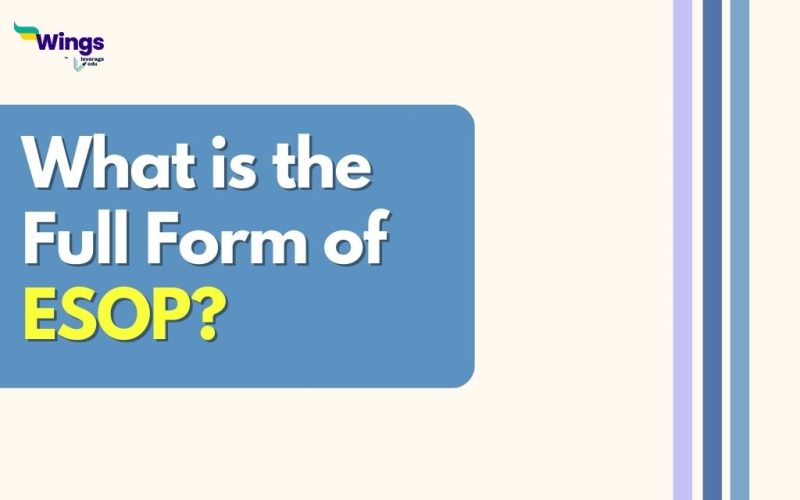The ESOP full form stands for Employee Stock Ownership Plan. It refers to a benefits programme for employees that grants them a stake in the company. Employee stock ownership programmes are given out as direct stock, profit-sharing schemes, or bonuses, and it is entirely up to the business to decide who is eligible to participate.
Employee stock ownership plans are merely options that could be bought at a certain price before the exercise date. Employers must adhere to the guidelines outlined in the Company’s policies when offering employee stock ownership programmes to its staff members.
How Do ESOPs Work?
Table of Contents [show]
An organisation offers ESOPs to its employees in exchange for the employees purchasing a predetermined number of shares of the company at a predetermined price following the option period (a predetermined number of years). The employee must complete the pre-defined vesting term before they can exercise their option, requiring them to continue working for the company until they exercise all or part of the stock options.
Employee stock purchases through ESOPs are permitted at prices below market value. Additionally, workers can profit from their investments by selling shares acquired through ESOPs. The company is required to buy back the ESOP at fair market value within 60 days if an employee departs or retires prior to the vesting term.
ESOP Initial Costs & Distributions
In the initial costs of an Employee Stock Ownership Plan (ESOP) in India, you may include legal fees, accounting fees, and administrative expenditures.
The cost of establishing and sustaining an ESOP varies according to its size and complexity.
Furthermore, ESOP distributions in India may occur in a variety of ways.
When an employee exercises their stock option to obtain shares, they have the option of selling them immediately or storing them for future appreciation.
If the employee decides to sell the shares, we will send the proceeds to them, minus any taxes due on the gain. If the employee agrees to keep the shares, they will own a piece of the company and may be eligible for dividends or capital gains if the stock price rises.
Benefits of ESOPs
There are various advantages to using an ESOP. Some are listed below for your convenience:
- The most significant advantage of an ESOP is that employees become shareholders in the company. Their vested stake in the company’s success directly links to their retirement savings.
- You can also use ESOPs to sell a business in a tax-advantaged manner. If you roll over the proceeds of the sale into an ESOP, you can delay capital gains taxes on the sale.
- Employee stock ownership plans (ESOPs) help recruit and retain employees. Because employees have a financial stake in the company’s success, employee turnover is often lower in companies with ESOPs.
- ESOPs can also assist businesses in raising financing. Because ESOPs are more secure assets, banks and other financial institutions are frequently more inclined to lend money to them.
Disadvantages of ESOPs
In addition to its advantages, ESOP has some disadvantages, including:
- Employees may be unfamiliar with the stock market and are unsure how to invest.
- To hold the stock, the corporation must establish a trust, which can be pricey.
- Employees may become overly focused on the stock price rather than the long-term profitability of the organization.
- The corporation must be willing to hand over some power to the employees.
Rules of ESOPs
The following are the ESOP rules:
- An employee stock ownership plan is a type of retirement plan in which employees can invest in company stock.
- Employees can buy stock through payroll deductions, and the employer can contribute to the plan on their behalf.
- ESOPs follow the same rules and regulations as other types of retirement plans, such as 401(k)s.
- Employee ownership can enhance motivation and productivity since employees have a vested interest in the company’s success.
- You can utilize ESOPs to attract and retain outstanding people, as well as to help employees gain ownership of the company.
- ESOPs are classified into three types: cash ESOPs, leveraged ESOPs, and Employee Stock Purchase Plans (ESPPs).
- ESOPs can be combined with other retirement plans, like as 401(k)s.
- Employee ownership may be a powerful tool for businesses of all sizes.
Must Read: What is the Full Form of PPF?
Must Read: What is the Full Form of MRTPC?
This was all about ESOP full form. Visit our Full Form Page to discover more intriguing articles about full forms. You can also check out the consolidated 300+ full forms list! And don’t forget to subscribe to Leverage Edu. Thank you for reading!
 One app for all your study abroad needs
One app for all your study abroad needs















 45,000+ students trusted us with their dreams. Take the first step today!
45,000+ students trusted us with their dreams. Take the first step today!
